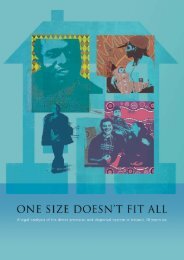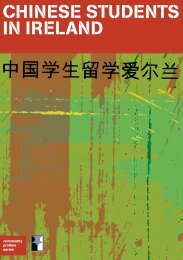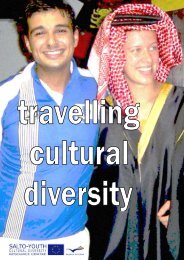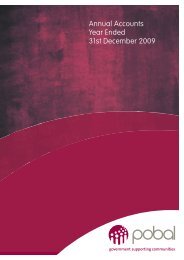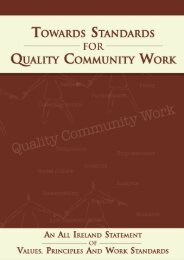Intercultural Education in the Post-Primary School - National Council ...
Intercultural Education in the Post-Primary School - National Council ...
Intercultural Education in the Post-Primary School - National Council ...
You also want an ePaper? Increase the reach of your titles
YUMPU automatically turns print PDFs into web optimized ePapers that Google loves.
CLASSROOM PLANNING 4CHECKLIST: WHAT INFORMATION SHOULD THESUBJECT TEACHER HAVE WHEN A NEWSTUDENT JOINS THE CLASS?How are <strong>the</strong> names of <strong>the</strong> student and<strong>the</strong>ir parents correctly pronounced?What language(s) does <strong>the</strong> student have,and what is <strong>the</strong>ir level of proficiency <strong>in</strong><strong>the</strong>se language(s)?How does one say some key phrases <strong>in</strong><strong>the</strong> student’s first language, such as agreet<strong>in</strong>g, ‘please/thank you’, ‘jo<strong>in</strong> <strong>in</strong>’,‘stop’, ‘well done/very good’, etc?Are <strong>the</strong>re subjects <strong>the</strong> student will not betak<strong>in</strong>g and what will <strong>the</strong>y be do<strong>in</strong>g dur<strong>in</strong>gthose times?Are <strong>the</strong>re any cultural practices thatmight affect classroom <strong>in</strong>teraction? Are<strong>the</strong>re actions which are deemed<strong>in</strong>appropriate or rude <strong>in</strong> <strong>the</strong> student’shome culture but which may not causeoffence to members of <strong>the</strong> dom<strong>in</strong>antethnic group, or vice versa (show<strong>in</strong>gsomeone an open palm or <strong>the</strong> soles of <strong>the</strong>foot may be rude <strong>in</strong> some cultures; ayoung person mak<strong>in</strong>g eye contact with anadult may be rude <strong>in</strong> some Africancultures while <strong>in</strong> Traveller culture youngpeople often speak very directly andopenly to adults, someth<strong>in</strong>g which issometimes seen as rude <strong>in</strong> schools;stand<strong>in</strong>g close to a person may bedeemed rude <strong>in</strong> some cultures, while itmay be normal <strong>in</strong> o<strong>the</strong>rs etc.)? How isteach<strong>in</strong>g <strong>the</strong> student <strong>the</strong> culture of <strong>the</strong>school to be handled?What is <strong>the</strong> student’s religion, how is itpractised, and has this any implicationsfor classroom plann<strong>in</strong>g?Will <strong>the</strong> student have specificrequirements concern<strong>in</strong>g food, jewelleryor cloth<strong>in</strong>g (for example, <strong>the</strong> range oftastes catered for by <strong>the</strong> school canteenor <strong>the</strong> symbolism of <strong>the</strong> schools crest on<strong>the</strong> school uniform)?CREATING A SUPPORTIVE LANGUAGEENVIRONMENTLanguage is a key component of a person’sidentity as well as play<strong>in</strong>g a central part <strong>in</strong><strong>the</strong> learn<strong>in</strong>g process. Ireland is, and hashistorically been, characterised by l<strong>in</strong>guisticdiversity, with both Irish and Englishexist<strong>in</strong>g as first languages. To this must beadded <strong>the</strong> range of languages of recentimmigrants. The right to have one’s ownlanguage is important <strong>in</strong> enabl<strong>in</strong>g people todevelop a strong positive self-image. Peoplealso generally f<strong>in</strong>d it easier to developcomplex th<strong>in</strong>k<strong>in</strong>g <strong>in</strong> <strong>the</strong>ir first language.For both ethical and educational reasons,<strong>the</strong>n, it is important that <strong>the</strong> student’s firstlanguage is valued and affirmed with<strong>in</strong> <strong>the</strong>school context. It is also important tocreate an environment that supports <strong>the</strong>learn<strong>in</strong>g of a second language.Learn<strong>in</strong>g <strong>in</strong> a multi-l<strong>in</strong>gual environmentcan be a positive experience for allstudents. It highlights concretely <strong>the</strong>diversity of languages and cultures <strong>in</strong> <strong>the</strong>world and, as such, constitutes animportant resource for develop<strong>in</strong>g<strong>in</strong>tercultural capacities and abilities <strong>in</strong> allstudents irrespective of <strong>the</strong>ir ethnicity.Recognition and affirmation of <strong>the</strong>student’s first language can be achievedthrough• <strong>the</strong> teacher and students learn<strong>in</strong>gsome key words or phrases (greet<strong>in</strong>gs,simple <strong>in</strong>structions, etc.) <strong>in</strong> <strong>the</strong> students’first language• communicat<strong>in</strong>g positive attitudestowards l<strong>in</strong>guistic diversity andmulti-l<strong>in</strong>gual student’s skills andrecognis<strong>in</strong>g <strong>the</strong> capacities of secondlanguage learners ra<strong>the</strong>r than identify<strong>in</strong>g<strong>the</strong>m primarily as people with ‘languageneeds’• provid<strong>in</strong>g multil<strong>in</strong>gual resourceswhere possible.<strong>Intercultural</strong> <strong>Education</strong> <strong>in</strong> <strong>the</strong> <strong>Post</strong>-<strong>Primary</strong> <strong>School</strong> 45








